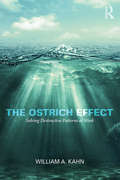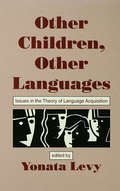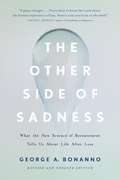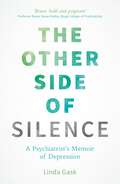- Table View
- List View
Ostracism, Exclusion, and Rejection (Frontiers of Social Psychology)
by Kipling D. Williams Steve A. NidaOstracism, Exclusion, and Rejection examines research into the related phenomena of ostracism, exclusion and rejection. Most individuals have experienced both sides of the coin: being ostracized and ostracizing others. People experience mild forms of ostracism on a daily basis, but some endure years and decades of being the social outcast. How does it feel to be shunned, left out, not wanted? Research suggests that even the mildest and briefest forms of ostracism are painful and have downstream consequences to our feelings of social connection. Longer-term ostracism has devastating consequences on individuals’ health and well-being. This innovative compilation covers how being cast out affects the brain and body chemistry, feelings and emotions, thoughts and beliefs, and behaviors. In addition to the primary focus on targets of ostracism, researchers also examine the motives and consequences of ostracizing. Social scientists from social psychology, developmental psychology, neuroscience, communication science, cross-cultural psychology, and anthropology tackle these questions with cutting-edge methods and provocative theories. A key volume for all in those fields, this book also presents applications from the schoolyard to the workplace, and sounds a much-needed call for further research on this universal behavior of all social animals.
Ostracism, Exclusion, and Rejection: Ostracism, Social Exclusion, Rejection, And Bullying (Frontiers of Social Psychology #Vol. 7)
by Kipling D. Williams Steve A. NidaOstracism, Exclusion, and Rejection examines research into the related phenomena of ostracism, exclusion and rejection. Most individuals have experienced both sides of the coin: being ostracized and ostracizing others. People experience mild forms of ostracism on a daily basis, but some endure years and decades of being the social outcast. How does it feel to be shunned, left out, not wanted? Research suggests that even the mildest and briefest forms of ostracism are painful and have downstream consequences to our feelings of social connection. Longer-term ostracism has devastating consequences on individuals’ health and well-being. This innovative compilation covers how being cast out affects the brain and body chemistry, feelings and emotions, thoughts and beliefs, and behaviors. In addition to the primary focus on targets of ostracism, researchers also examine the motives and consequences of ostracizing. Social scientists from social psychology, developmental psychology, neuroscience, communication science, cross-cultural psychology, and anthropology tackle these questions with cutting-edge methods and provocative theories. A key volume for all in those fields, this book also presents applications from the schoolyard to the workplace, and sounds a much-needed call for further research on this universal behavior of all social animals.
The Ostrich Effect: Solving Destructive Patterns at Work
by William A. KahnThe Ostrich Effect goes beyond the typical "how to" approach of most books that deal with difficult conversations at work. It aims to teach the reader what conversations to have, and when to have them, in order to solve destructive problems that occur in the workplace. Like the proverbial ostrich with its head in the sand, people often avoid confronting small issues at work, but, if avoided, these issues will escalate and inevitably wreak havoc. Drawing on a combination of social science research and Kahn’s practical experience as an organizational psychologist, the book examines the micro-processes that underlie the way in which these problems develop and flourish. These micro-processes are tiny, fleeting, and hardly noticeable, but when they are identified, something startling becomes apparent: there is a predictable pattern to this escalation. The book uses a variety of examples to demonstrate this pattern across a range of organizations and industries, and offers a toolkit to help guide the reader in resolving people problems at work. The toolkit focuses not on changing others, but on changing how we interact with others—our own behavior is the most powerful force for change that we have. The ostrich remains the symbol of those of us who foolishly ignore our problems while hoping that they will magically disappear. By identifying this "ostrich effect", the reader is empowered to re-frame and neutralize its impact.
The Ostrich Effect: Solving Destructive Patterns at Work
by William A. KahnThe Ostrich Effect goes beyond the typical "how to" approach of most books that deal with difficult conversations at work. It aims to teach the reader what conversations to have, and when to have them, in order to solve destructive problems that occur in the workplace. Like the proverbial ostrich with its head in the sand, people often avoid confronting small issues at work, but, if avoided, these issues will escalate and inevitably wreak havoc. Drawing on a combination of social science research and Kahn’s practical experience as an organizational psychologist, the book examines the micro-processes that underlie the way in which these problems develop and flourish. These micro-processes are tiny, fleeting, and hardly noticeable, but when they are identified, something startling becomes apparent: there is a predictable pattern to this escalation. The book uses a variety of examples to demonstrate this pattern across a range of organizations and industries, and offers a toolkit to help guide the reader in resolving people problems at work. The toolkit focuses not on changing others, but on changing how we interact with others—our own behavior is the most powerful force for change that we have. The ostrich remains the symbol of those of us who foolishly ignore our problems while hoping that they will magically disappear. By identifying this "ostrich effect", the reader is empowered to re-frame and neutralize its impact.
Other Banalities: Melanie Klein Revisited
by Jon MillsMelanie Klein is one of the few analysts whose body of work has inspired sociologists, philosophers, religious scholars, literary critics and political theorists, all attracted to the cross-fertilisation of her ideas. Other Banalities represents a long over-due exploration of her legacy, including contributions from acclaimed interdisciplinary scholars and practitioners. The contributors situate Klein within the history of the psychoanalytic movement, investigate her key theoretical and clinical advances, and look at how her thought has informed contemporary perspectives in the behavioural sciences and humanities. Topics covered range from Klein’s major psychological theories to clinical pathology, child development, philosophy, sociology, politics, religion, ethics and aesthetics. This volume reflects the auspicious future for Kleinian revivalism and demonstrates the broad relevance of Kleinian thought. It will be of great interest to scholars and practitioners of psychology, psychoanalysis and psychotherapy.
Other Banalities: Melanie Klein Revisited
by Jon MillsMelanie Klein is one of the few analysts whose body of work has inspired sociologists, philosophers, religious scholars, literary critics and political theorists, all attracted to the cross-fertilisation of her ideas. Other Banalities represents a long over-due exploration of her legacy, including contributions from acclaimed interdisciplinary scholars and practitioners. The contributors situate Klein within the history of the psychoanalytic movement, investigate her key theoretical and clinical advances, and look at how her thought has informed contemporary perspectives in the behavioural sciences and humanities. Topics covered range from Klein’s major psychological theories to clinical pathology, child development, philosophy, sociology, politics, religion, ethics and aesthetics. This volume reflects the auspicious future for Kleinian revivalism and demonstrates the broad relevance of Kleinian thought. It will be of great interest to scholars and practitioners of psychology, psychoanalysis and psychotherapy.
Other Children, Other Languages: Issues in the theory of Language Acquisition
by Yonata LevyThis volume investigates the implications of the study of populations other than educated, middle-class, normal children and languages other than English on a universal theory of language acquisition. Because the authors represent different theoretical orientations, their contributions permit the reader to appreciate the full spectrum of language acquisition research. Emphasis is placed on the principle ways in which data from pathology and from a variety of languages may affect universal statements. The contributors confront some of the major theoretical issues in acquisition.
Other Children, Other Languages: Issues in the theory of Language Acquisition
by Yonata LevyThis volume investigates the implications of the study of populations other than educated, middle-class, normal children and languages other than English on a universal theory of language acquisition. Because the authors represent different theoretical orientations, their contributions permit the reader to appreciate the full spectrum of language acquisition research. Emphasis is placed on the principle ways in which data from pathology and from a variety of languages may affect universal statements. The contributors confront some of the major theoretical issues in acquisition.
The Other Depression: Bipolar Disorder
by Robert Grieco Laura EdwardsIn The Other Depression, Grieco and Edwards help people understand and destigmatize those afflicted with bipolar disorder. Topics discussed include the genetic signature and environmental stresses and underpinnings of this disease, along with how it alters the functioning of the brain, and how it can be treated. The authors also introduce resources available to bipolar people and their families and suggest strategies for coping and getting on with life.
The Other Depression: Bipolar Disorder
by Robert Grieco Laura EdwardsIn The Other Depression, Grieco and Edwards help people understand and destigmatize those afflicted with bipolar disorder. Topics discussed include the genetic signature and environmental stresses and underpinnings of this disease, along with how it alters the functioning of the brain, and how it can be treated. The authors also introduce resources available to bipolar people and their families and suggest strategies for coping and getting on with life.
Other Esteem: Meaningful Life in a Multicultural Society (Accelerated Development Ser.)
by Philip O. HwangFirst published in 2000. Routledge is an imprint of Taylor & Francis, an informa company.
Other Esteem: Meaningful Life in a Multicultural Society
by Philip O. HwangFirst published in 2000. Routledge is an imprint of Taylor & Francis, an informa company.
The Other Half of Asperger Syndrome (Autism Spectrum Disorder): A Guide to Living in an Intimate Relationship with a Partner who is on the Autism Spectrum Second Edition
by Maxine AstonDoes your other half have Asperger Syndrome (AS) or do you suspect that he or she is on the autism spectrum? This quick and helpful guide provides all the information you need for relationship success with your AS partner. Maxine Aston offers relationship advice that draws on over a decade of counselling experience.
The Other Kind of Funnies: Comics in Technical Communication (Baywood's Technical Communications)
by Han YuThe Other Kind of Funnies refutes the mainstream American cultural assumption that comics have little to do with technical communication-that the former are entertaining (in a low-brow sense) and juvenile, whereas the latter is practical and serious (to the point of stuffiness). The first of its kind, this book demonstrates the exciting possibilities of using comics in technical communication. It defines comics as a medium and art form that includes cartoons, comic strips, comic books, and graphic novels; provides conceptual and historical backgrounds on comics; and discusses the appeals and challenges of using comics-style technical communication. More specifically, it examines comics-style instructions, educational materials, health/risk communication, and political/propaganda communication. The author argues that comics-style technical communication encourages reader participation, produces covert persuasion, facilitates intercultural communication, benefits underprivileged audiences such as children and readers of lower literacy, and challenges the positivist view of technical communication. An abundance of comics-style technical communication examples, carefully selected from across cultures and times, demonstrates the argument. While the book proposes that comics can create user-friendly, visually oriented, engaging, and socially responsible technical communication, it is also quick to acknowledge the limitations and challenges of comics-style technical communication and provides heuristics on how to cope with them. The Other Kind of Funnies is unique in its interdisciplinary approach. It focuses on technical communication but speaks to design, cultural and intercultural studies, historical studies, and to some extent, education, politics, and art.
The Other Kind of Funnies: Comics in Technical Communication (Baywood's Technical Communications)
by Han YuThe Other Kind of Funnies refutes the mainstream American cultural assumption that comics have little to do with technical communication-that the former are entertaining (in a low-brow sense) and juvenile, whereas the latter is practical and serious (to the point of stuffiness). The first of its kind, this book demonstrates the exciting possibilities of using comics in technical communication. It defines comics as a medium and art form that includes cartoons, comic strips, comic books, and graphic novels; provides conceptual and historical backgrounds on comics; and discusses the appeals and challenges of using comics-style technical communication. More specifically, it examines comics-style instructions, educational materials, health/risk communication, and political/propaganda communication. The author argues that comics-style technical communication encourages reader participation, produces covert persuasion, facilitates intercultural communication, benefits underprivileged audiences such as children and readers of lower literacy, and challenges the positivist view of technical communication. An abundance of comics-style technical communication examples, carefully selected from across cultures and times, demonstrates the argument. While the book proposes that comics can create user-friendly, visually oriented, engaging, and socially responsible technical communication, it is also quick to acknowledge the limitations and challenges of comics-style technical communication and provides heuristics on how to cope with them. The Other Kind of Funnies is unique in its interdisciplinary approach. It focuses on technical communication but speaks to design, cultural and intercultural studies, historical studies, and to some extent, education, politics, and art.
Other People's Kids: Social Expectations and American Adults? Involvement with Children and Adolescents (The Search Institute Series on Developmentally Attentive Community and Society #2)
by Peter C. ScalesAccording to the study conducted by Gallup Organization, only a minority of Americans experience consistent normative motivation for engaging with other people's children. Social norms theory suggests that adults are more likely to get deeply involved if that involvement is viewed as highly important, and if they perceive a social expectation to do so. This volume examines the nature of social norms in general and in relationship to children and adolescents. The book examines the complex dynamics of understanding the appropriate roles of parents and other adults in young people's healthy development. The volume also presents the study's findings in detail, including numerous areas of consensus among American adults, differences among American adults, and the gap between perceived importance and actual engagement. A wide-ranging literature synthesis suggests implications for both personal and collective actions with potential to change norms that inhibit engagement and to strengthen values that encourage engagement.
The Other Side of Desire: Four Journeys into the Far Realms of Lust and Longing
by Daniel BergnerJacob is a man with an overwhelming attraction to female feet. The Baroness is a clothing designer and evangelical sadist. Roy is a wedding band singer entranced by his step daughter. Ron and Laura are simply in love - only Laura lost both her legs in a car accident, and Ron is beguiled by a beauty many would be blind to. How do we deal with desire? Our own, and the desires of others? How do we comprehend desires that are extreme, or unacceptable? And how do those who have them, live with them? In A Map of Desire Daniel Bergner takes us on a journey into human passion suffered, endured, and celebrated. Desire is a sometimes anarchic, sometimes ecstatic, sometimes destructive, sometimes redeeming, and always powerful force.Immersing himself in it through the people whose lives he follows and the scientists he spends time with who are trying to understand it, slowly he exposes and illuminates layers of our humanity.
The Other Side of Happiness: Embracing a More Fearless Approach to Living
by Dr Brock Bastian'Required reading ... Brock Bastian expertly picks apart the fundamental idea that humans thrive when they approach pleasure and avoid pain, explaining why hardship sometimes yields richer lives that are laden with meaning, deep social connections, and unexpected bliss' Adam Alter, author of Drunk Tank Pink In today's culture, happiness has become the new marker of success, while hardships are viewed as personal weaknesses, or problems to be fixed. We increasingly try to eradicate pain through medication and by insulating ourselves from risk and offence, despite being the safest generation to have ever lived. Yet in his research, renowned social psychologist Brock Bastian has found that suffering and sadness are neither antithetical to happiness nor incidental to it: they are a necessary ingredient for emotional well-being.Drawing on psychology, neuroscience and internationally acclaimed findings from Bastian's own lab, The Other Side of Happiness encourages us to take a more fearless approach to living. The most thrilling moments of our lives are often balanced on a knife edge between pleasure and pain, whether it is finding your true love, holding your new-born for the first time, finishing a marathon or even plunging into an icy sea. This is because pain and the threat of loss quite literally increase our capacity for happiness, as Bastian reveals, making us stronger, more resilient, more connected to other people and more attuned to what truly matters. Pain even makes us more mindful, since in our darkest moments we are especially focused and aware of the world around us. Our addiction to positivity and the pursuit of pleasure is actually making us miserable. Brock Bastian shows that, without some pain, we have no real way to achieve and appreciate the kind of happiness that is true and transcendent.
The Other Side of Psychiatric Care (New Approaches to Care)
by Margaret Garland illus Gillian SimmondsThe Other Side of Sadness: What the New Science of Bereavement Tells Us About Life After Loss
by George A. BonannoIn this thoroughly revised and updated classic, a renowned psychologist shows that mourning is far from predictable, and all of us share a surprising ability to be resilientThe conventional view of grieving--encapsulated by the famous five stages of grief: denial, anger, bargaining, depression, and acceptance--is defined by a mourning process that we can only hope to accept and endure. In The Other Side of Sadness, psychologist and emotions expert George Bonanno argues otherwise. Our inborn emotions--anger and denial, but also relief and joy--help us deal effectively with loss. To expect or require only grief-stricken behavior from the bereaved does them harm. In fact, grieving goes beyond mere sadness, and it can actually deepen interpersonal connections and even lead to a new sense of meaning in life.
The Other Side of Silence: A Psychiatrist's Memoir of Depression
by Linda GaskHaving spent her life trying to patch up the souls of others, psychiatrist Linda Gask eventually learnt to focus on her own depression and take care of herself, too. Artfully crafted and told with warmth and honesty, this is the story of Linda’s journey, interwoven with insights into her patients’ diverse experiences of depression.
The Other Side of Suffering: Finding a Path to Peace after Tragedy
by Katie E. CherryIn this work, the author addresses a perennial question: how does someone recover from a catastrophic disaster or other personal tragedy? The answer, she suggests, may come from coastal residents who survived the 2005 Hurricanes Katrina and Rita. These survivors endured a long and painful journey after losing homes and communities in these deadly storms, and their experiences provide an authentic and relatable example for other people who must overcome a life changing tragedy. The Other Side of Suffering is based on behavioral research conducted by the author in the years after the hurricanes. In her research, Katie Cherry logged thousands of miles crisscrossing the Louisiana coastline and spoke with over 190 current and former coastal residents with catastrophic losses after Katrina. The author begins with an overview of the human impact of these disasters, and then focuses on the community impact on two coastal parishes in southern Louisiana. The incorporation of the personal journal entries of a Katrina survivor provides an intimate glimpse into the long days and months that over a million displaced Gulf Coast residences experienced. From this research, the author identifies six evidence-based principles of healing: faith and humor, respect and gratitude, and acceptance and silver linings. Colorful illustrations and direct quotes from the respondents bring these principles to life. Along with a path to healing, the book also discusses grief and the new normal after a disaster, as well as obstacles that may thwart the healing process. Ultimately, the work emphasizes the importance of recovering daily routines and observances as life goes on after disaster.
The Other Side of Suffering: Finding a Path to Peace after Tragedy
by Katie E. CherryIn this work, the author addresses a perennial question: how does someone recover from a catastrophic disaster or other personal tragedy? The answer, she suggests, may come from coastal residents who survived the 2005 Hurricanes Katrina and Rita. These survivors endured a long and painful journey after losing homes and communities in these deadly storms, and their experiences provide an authentic and relatable example for other people who must overcome a life changing tragedy. The Other Side of Suffering is based on behavioral research conducted by the author in the years after the hurricanes. In her research, Katie Cherry logged thousands of miles crisscrossing the Louisiana coastline and spoke with over 190 current and former coastal residents with catastrophic losses after Katrina. The author begins with an overview of the human impact of these disasters, and then focuses on the community impact on two coastal parishes in southern Louisiana. The incorporation of the personal journal entries of a Katrina survivor provides an intimate glimpse into the long days and months that over a million displaced Gulf Coast residences experienced. From this research, the author identifies six evidence-based principles of healing: faith and humor, respect and gratitude, and acceptance and silver linings. Colorful illustrations and direct quotes from the respondents bring these principles to life. Along with a path to healing, the book also discusses grief and the new normal after a disaster, as well as obstacles that may thwart the healing process. Ultimately, the work emphasizes the importance of recovering daily routines and observances as life goes on after disaster.
The Other Side of the Error Term: Aging and Development as Model Systems in Cognitive Neuroscience (ISSN #Volume 125)
by N. RazIt has been said more than once in psychology that one person's effect is another person's error term. By minimising and occasionally ignoring individual and group variability cognitive psychology has yieled many fine achievements. However, when investigators are working with special populations, the subjects, and the unique nature of the sample, come into focus and become the goal in itself. For developmental psychologists, gerontologists and psychopathologists, research progresses with an eye on their target populations of study. Yet every good study in any of these domains inevitably has another dimension. Whenever a study is designed to turn a spotlight on a special population, the light is also shed on the mainstream from which the target deviates.This book examines what we can learn about general and universal phenomena in cognition and its brain substrates from examining the odd, the rare, the transient, the exceptional and the abnormal.

















